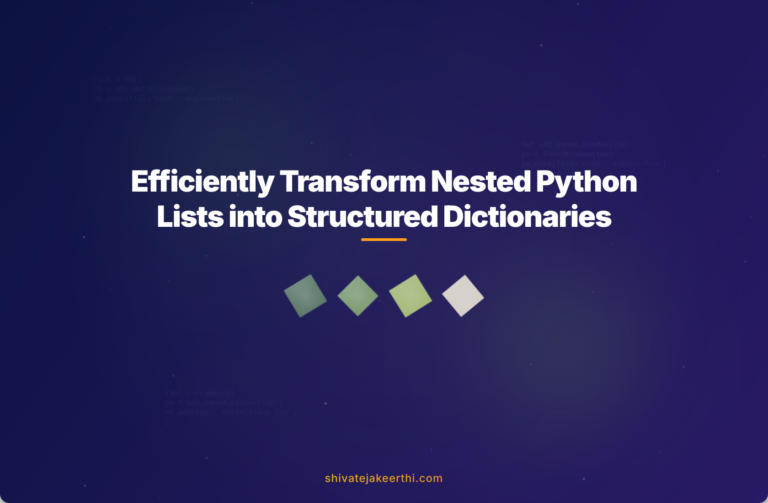When dealing with complex data structures in Python, there’s a common scenario developers frequently encounter—parsing nested structures from seemingly simple flat lists. These flat lists often contain strings and numbers, each carrying specific meanings or relationships. Parsing these elements into meaningful, hierarchical structures can be challenging, yet mastering this concept is vital for clean, efficient coding.
Let’s take an example to illustrate what we mean clearly. Suppose you’re given the following flat list:
["add", 3, ["multiply", 2, 4], ["subtract", 10, ["divide", 4, 2]]]
At first glance, the data seems straightforward, combining functions like “add,” “multiply,” “subtract,” and “divide” with their numerical arguments. But to evaluate or manipulate the expressions, Python must convert them into a nested, structured format clearly indicating function hierarchies.
The expected parsed outcome would look something like:
{
"add": [
3,
{"multiply": [2, 4]},
{"subtract": [10, {"divide": [4, 2]}]}
]
}
This neatly structured output simplifies later evaluation or data handling, clearly revealing the nested relationships of functions and arguments.
Let’s Clearly Understand What’s Going On
To simplify the scenario further, examine a smaller example first:
["multiply", 3, ["divide", 6, 2]]
The above flat list can intuitively translate to:
{"multiply": [3, {"divide": [6, 2]}]}
Here’s what’s happening:
- “multiply” is recognized as a function, with two arguments: 3 and another nested “divide” function.
- The number “3” is a numeric argument directly associated with “multiply.”
- The nested list [“divide”, 6, 2] defines another function “divide,” which itself takes numeric arguments.
This structure clearly indicates a hierarchy—”divide” is nested within “multiply,” making functions evaluated from the inside out. When dealing with computational expressions, JSON configurations, or interpreting syntax trees, properly handling deeply nested data becomes critical.
Initial Approach and Common Issues
One might initially consider a straightforward recursive approach like this:
def parse_nested(lst):
if isinstance(lst, list):
function = lst[0]
args = []
for item in lst[1:]:
if isinstance(item, list):
args.append(parse_nested(item))
else:
args.append(item)
return {function: args}
else:
return lst
example_input = ["add", 3, ["multiply", 2, ["subtract", 5, 2]]]
print(parse_nested(example_input))
While this solution seems elegant at first glance, it quickly shows its limitations. It correctly handles straightforward nested cases, but consider nested lists with edge cases—like repetitive function names or special characters.
Another crucial issue is maintainability and readability; deeply nested recursion can become tough to debug. If the data structure violates expected formats or contains incorrect nesting, this recursive setup can lead to obscure bugs or stack overflow errors.
A Robust and Effective Approach: Using Dictionaries and Recursion
To improve our implementation, it’s helpful to clearly organize function names and arguments using Python dictionaries. Let’s clarify what we mean through this enhanced strategy:
- Clearly define function names as distinct dictionary keys.
- Allow arguments to be clearly represented as values of dictionary keys.
Let’s illustrate this more robust approach clearly using a dictionary construct:
def parse_nested_structure(lst):
if not isinstance(lst, list):
return lst
function, *args = lst
parsed_args = [
parse_nested_structure(arg) if isinstance(arg, list) else arg
for arg in args
]
return {function: parsed_args}
Here, “function” is directly assigned from the first element in the input list. The rest of the list (“args”) represents arguments that could themselves be functions (nested lists) or simple values. This approach gracefully handles recursion, clearly marking function names from arguments.
Refining the Approach for Edge Cases and Improved Handling
While the above solution handles many cases effectively, let’s further consideration special scenarios, such as:
- Repeating function names multiple times at different nesting levels.
- Escape characters or strings containing special characters.
- Efficiency considerations for massively nested structures.
We can enhance the algorithm to explicitly handle repeating functions by appending unique identifiers or nesting functions further:
def advanced_parser(lst):
if not isinstance(lst, list):
return lst
function, *args = lst
parsed_args = []
for idx, arg in enumerate(args):
# Assign unique keys if function names repeat
key = f"{function}_{idx}" if function in arg else function
if isinstance(arg, list):
parsed_args.append(advanced_parser(arg))
else:
parsed_args.append(arg)
return {function: parsed_args}
This refined approach neatly organizes repetitive function scenarios, helping ensure that your parsing logic maintains clarity even when dealing with large nested data.
Another practical consideration is handling special characters or escaping strings. Python provides built-in tools like the JSON module, which facilitates dealing with escape sequences and encodings efficiently. Leveraging existing libraries like these can enhance stability and correctness further.
Thorough Testing and Validation
Always thoroughly test your approach using real-world scenarios. Consider robust validation, comparing outputs against known valid examples, and ensure edge cases are properly managed. For instance:
example_input = ["add", 3, ["multiply", 2, 4], ["subtract", 10, ["divide", 4, 2]]]
expected_output = {
"add": [
3,
{"multiply": [2, 4]},
{"subtract": [10, {"divide": [4, 2]}]}
]
}
parsed_result = parse_nested_structure(example_input)
print(parsed_result == expected_output)
Such tests clearly confirm if your nested structure parser works effectively and handles multiple complex scenarios gracefully.
Comparing the new solution with previously attempted methods helps illustrate your improvements clearly. Detailed tests ensure correctness, reliability, and readiness for production use.
Summarizing the Benefits of the Improved Implementation
Building effective parsers for nested structures from flat lists significantly simplifies data processing tasks:
- Improved Code Readability: Clearly structured dictionaries representing functions and arguments enhances readability and maintainability.
- Robust Error Handling: Handling edge cases gracefully reduces bugs and debugging time.
- Efficiency and Scalability: Avoiding overly complex recursion pitfalls supports scalability.
- Flexibility: Clearly delineated function parsing allows easier integration within larger frameworks.
Future enhancements could include:
- Utilizing parsers like Python’s AST module for even more powerful parsing scenarios.
- Leveraging JSONSchemas to validate parsed structures ensuring they conform strictly defined standards.
Effectively parsing nested structures ensures applications remain robust, maintainable, and efficient. Have you encountered unusual or tricky cases while parsing nested lists in Python? I’d love to hear about your solutions or questions in the comments below.



0 Comments